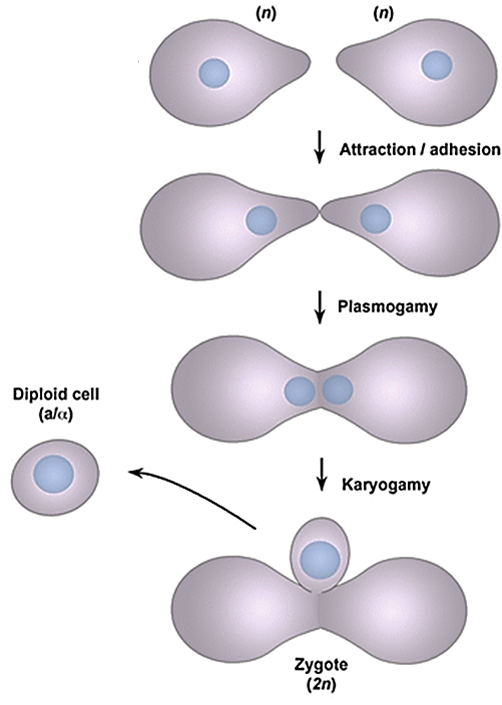
Karyogamy is?
A. The fusion of two germ cells
B. The Fusion of two gametic nuclei
C. The Fusion of somatic cells and reproductive cells
D. The Fusion of two somatic cells.
Answer
476.4k+ views
Hint: The term Karyogamy comes from the Greek word 'karyo' means ‘nut’. Karyogamy is the final step of the fusion process. For Karyogamy to occur the cell membrane and cytoplasm of each cell must fuse by the process known as plasmogamy.
Complete answer:
-Karyogamy is the fusion of two gametic nuclei that takes place after the fusion of two haploid eukaryotic cells, each carrying one complete copy of the organism's genome. Once the cell membrane is joined the nuclei is referred to as pronuclei. Once the cell membrane, cytoplasm, and pronuclei fuse it results in the formation of a single diploid cell. This diploid cell is called zygospores (in case of fungi) or zygote in general.
Figure 1: Cell fusion

Additional information:
Karyogamy is a process usually seen during sexual reproduction involving the fusion of two haploid gametes. That results in the formation of a zygote. In the case of fungi, karyogamy is followed by meiosis to restore the haploid phase.
Note: The fusion of two protoplasts that is the fusion of two cell contents is known as Plasmogamy. A process that brings together two compatible haploid nuclei. The fusion of these haploid nuclei is known as Karyogamy that results in the formation of a diploid cell containing a single nucleus with two sets of chromosomes, one from each parent.
Complete answer:
-Karyogamy is the fusion of two gametic nuclei that takes place after the fusion of two haploid eukaryotic cells, each carrying one complete copy of the organism's genome. Once the cell membrane is joined the nuclei is referred to as pronuclei. Once the cell membrane, cytoplasm, and pronuclei fuse it results in the formation of a single diploid cell. This diploid cell is called zygospores (in case of fungi) or zygote in general.
Figure 1: Cell fusion

Additional information:
Karyogamy is a process usually seen during sexual reproduction involving the fusion of two haploid gametes. That results in the formation of a zygote. In the case of fungi, karyogamy is followed by meiosis to restore the haploid phase.
Note: The fusion of two protoplasts that is the fusion of two cell contents is known as Plasmogamy. A process that brings together two compatible haploid nuclei. The fusion of these haploid nuclei is known as Karyogamy that results in the formation of a diploid cell containing a single nucleus with two sets of chromosomes, one from each parent.
Recently Updated Pages
Master Class 11 English: Engaging Questions & Answers for Success

Master Class 11 Computer Science: Engaging Questions & Answers for Success

Master Class 11 Maths: Engaging Questions & Answers for Success

Master Class 11 Social Science: Engaging Questions & Answers for Success

Master Class 11 Economics: Engaging Questions & Answers for Success

Master Class 11 Business Studies: Engaging Questions & Answers for Success

Trending doubts
10 examples of friction in our daily life

What problem did Carter face when he reached the mummy class 11 english CBSE

One Metric ton is equal to kg A 10000 B 1000 C 100 class 11 physics CBSE

Difference Between Prokaryotic Cells and Eukaryotic Cells

State and prove Bernoullis theorem class 11 physics CBSE

The sequence of spore production in Puccinia wheat class 11 biology CBSE




